Growing Grape Hyacinth Indoors - Forcing Grape Hyacinth Over Winter
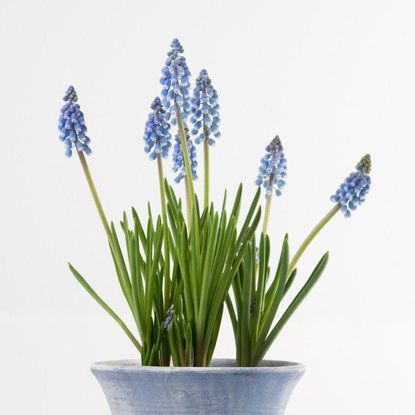

Reminiscent of clustered upside-down grapes and extremely fragrant, grape hyacinths (Muscari) have long since been admired. These old-time favorites emerge in fall with grass-like foliage and by late winter or early spring, they explode into bloom with clusters of tiny cobalt blue, bell-shaped flowers. Who has time to wait though? It's easy to force grape hyacinth into early bloom, growing grape hyacinth indoors throughout winter and adding color and fragrance to your home.
Forcing Grape Hyacinth Indoors
To force grape hyacinth indoors, you'll need to dig up existing bulbs or purchase them in late summer or early fall. To enjoy blooms from January through March, pot the bulbs for chilling in September or October. Grape hyacinth bulbs require a cold period of 35 to 48 degrees F. (2-9 C.) for at least ten weeks. Plant the bulbs, anywhere from 12 to 15 inches (31-38 cm.), in a bulb pan or other suitable container at least 6 inches (15 cm.) around and 6 to 8 inches (15-20 cm.) deep. Moist potting soil is preferable, filling the pot to within a couple inches (5 cm.) of its rim and placing the bulbs about an inch (2.5 cm.) apart with their tips pointing upward. Move the pot to a cool, dark area (for about ten weeks). Depending on your location, this might be an unheated basement or cellar, cold frame, well-ventilated crawlspace, or even an unused refrigerator (keeping the bulbs away from any fruits and vegetables).
Growing Grape Hyacinth Indoors
Check the bulbs occasionally during the chilling period, watering weekly. Water just enough to keep the soil moist not wet. Once the roots begin spilling out from the bottom of the pot, bring the grape hyacinth indoors. Choose a bright, slightly cool (not cold) area of your home in order to stimulate flowering. Continue to keep the soil moist. Once grape hyacinth blooms appear, you can prolong their flowering by keeping them located in cooler areas of the home. Likewise, you can plant several pots at various intervals and bring them inside in stages to enjoy longer flowering displays. Forcing grape hyacinth and growing grape hyacinth indoors is an easy and fun way to enjoy their beautiful, fragrant, grape-like blooms early in the season.
Gardening tips, videos, info and more delivered right to your inbox!
Sign up for the Gardening Know How newsletter today and receive a free download of our DIY eBook "Bring Your Garden Indoors: 13 DIY Projects For Fall And Winter".

Nikki Tilley has been gardening for nearly three decades. The former Senior Editor and Archivist of Gardening Know How, Nikki has also authored six gardening books.
-
 Elegant Exotics: 8 Beautiful Amaryllis Varieties That Will Brighten Any Holiday Display
Elegant Exotics: 8 Beautiful Amaryllis Varieties That Will Brighten Any Holiday DisplayWhether red, pink, white or variegated, the right amaryllis varieties can enhance any living space, especially during the holidays. We round up eight of the most exquisite
By Bonnie L. Grant
-
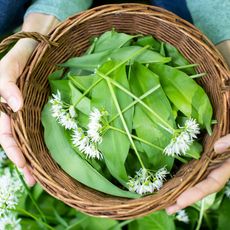 Forage For Herbs: 7 Tasty And Safe Wild Herbs To Pick Close To Your Own Backyard
Forage For Herbs: 7 Tasty And Safe Wild Herbs To Pick Close To Your Own BackyardIn addition to growing your own herbal staples, did you know there are several wild options out there that are safe and tasty – and free? Try foraging these 7 wild herbs
By Amy Grant
-
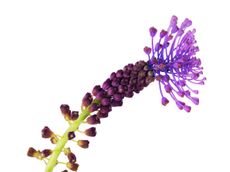 Feather Hyacinth Plants – Tips For Planting Feathered Grape Hyacinth Bulbs
Feather Hyacinth Plants – Tips For Planting Feathered Grape Hyacinth BulbsThe feather hyacinth, aka tassel hyacinth plant, can add another cool textural element to the garden with their feathery plumes. If you have some of these bulbs and are ready to go, click this article for tips on how to grow a Muscari feather hyacinth, including tips on their care.
By Teo Spengler
-
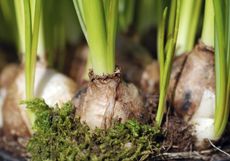 Digging Grape Hyacinths: How To Store Hyacinth Bulbs After Flowering
Digging Grape Hyacinths: How To Store Hyacinth Bulbs After FloweringGrape hyacinths are easy to dig up after flowering. Can you replant grape hyacinths? Yes, you can. Use the following article to get all the info you need about how to store hyacinth bulbs after flowering. Click here to learn more.
By Teo Spengler
-
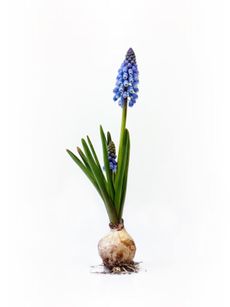 Muscari Propagation: Learn About Propagating Grape Hyacinth Bulbs And Seeds
Muscari Propagation: Learn About Propagating Grape Hyacinth Bulbs And SeedsIf you want to start growing grape hyacinth, or want to expand your collection, propagating grape hyacinths is very easy. Click this article to learn about propagation from grape hyacinth bulbs and grape hyacinth seeds.
By Liz Baessler
-
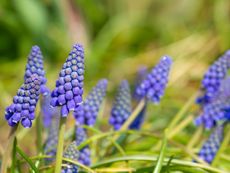 Grape Hyacinth After Flowering – Learn About Muscari Care After Blooming
Grape Hyacinth After Flowering – Learn About Muscari Care After BloomingWhen the grape hyacinth blooming season comes to an end, you need to care for the bulbs to protect and preserve them so that they can bloom again the following year. Read on for information about Muscari care after blooming.
By Teo Spengler
-
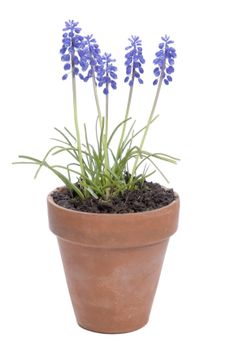 Growing Grape Hyacinth In Containers: How To Plant Muscari Bulbs In Pots
Growing Grape Hyacinth In Containers: How To Plant Muscari Bulbs In PotsGrape hyacinths are not, contrary to popular belief, related to hyacinths. They're actually a type of lily. They have a shockingly beautiful blue color (except when they're white) and a heavenly scent. They also grow very well in pots, and this article will help.
By Liz Baessler
-
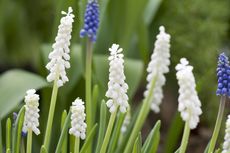 Types Of Grape Hyacinths: Grape Hyacinth Varieties For The Garden
Types Of Grape Hyacinths: Grape Hyacinth Varieties For The GardenThere are many grape hyacinth varieties, 40 species alone, that are resilient additions to the landscape mirroring the blue skies heralding winter's end. So what are grape hyacinth plants and what types of grape hyacinths are suited to your garden? Learn more here.
By Amy Grant
-
 Muscari Seed Planting: How To Grow Grape Hyacinth Flower Seeds
Muscari Seed Planting: How To Grow Grape Hyacinth Flower SeedsGrape hyacinth seed propagation is not as easy or quick as growing the plants from mature bulbs but it is an inexpensive way to further expand your stock of these appealing flowers. Click this article to learn more about Muscari seed planting.
By Bonnie L. Grant
-
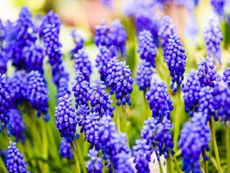 Caring For Grape Hyacinth In Lawns: How To Naturalize Grape Hyacinth Bulbs
Caring For Grape Hyacinth In Lawns: How To Naturalize Grape Hyacinth BulbsSome gardeners aren't crazy about the idea of grape hyacinths popping up in a tidy lawn, but others love the carefree appearance amid the grass. If you belong to the latter group, click here to learn how to naturalize grape hyacinth bulbs in your lawn.
By Mary H. Dyer